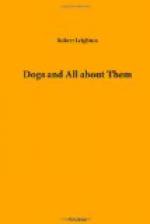* * * * *
VI. THE FIELD SPANIEL.—The modern Field Spaniel may be divided into two classes. Indeed, we may almost say at this stage of canine history, two breeds, as for several years past there has not been very much intermingling of blood between the Blacks and those known by the awkward designation of “Any Other Variety,” though, of course, all came originally from the same parent stock.
The black members of the family have always been given the pride of place, and accounted of most importance, though latterly their parti-coloured brethren seem to have rather overtaken them.
Among the really old writers there is one mention, and one only, of Spaniels of a black colour. Arcussia speaks of them, and of their being used in connection with the sport of hawking, but from his time up to the middle of the nineteenth century, though many colours are spoken of as being appropriate to the various breeds of Spaniels, no author mentions black.
The first strain of blacks of which we know much belonged to Mr. F. Burdett, and was obtained from a Mr. Footman, of Lutterworth, Leicestershire, who was supposed to have owned them for some time. Mr. Burdett’s Bob and Frank may be found at the head of very many of the best pedigrees. At his death most of his Spaniels became the property of Mr. Jones, of Oscott, and Mr. Phineas Bullock, of Bilston, the latter of whom was most extraordinarily successful, and owned a kennel of Field Spaniels which was practically unbeatable between the dates of the first Birmingham Show in 1861 and the publication of the first volume of the Kennel Club’s Stud Book in 1874, many, if not most, of the dogs which won for other owners having been bred by him. His Nellie and Bob, who won the chief prizes year after year at all the leading shows, were probably the two best specimens of their day. Another most successful breeder was Mr. W. W. Boulton, of Beverley, whose kennel produced many celebrated dogs, including Beverlac, said to be the largest Field Spaniel ever exhibited, and Rolf, whose union with Belle produced four bitches who were destined, when mated with Nigger, a dog of Mr. Bullock’s breeding, to form the foundation of the equally if not more famous kennel belonging to Mr. T. Jacobs, of Newton Abbot.




